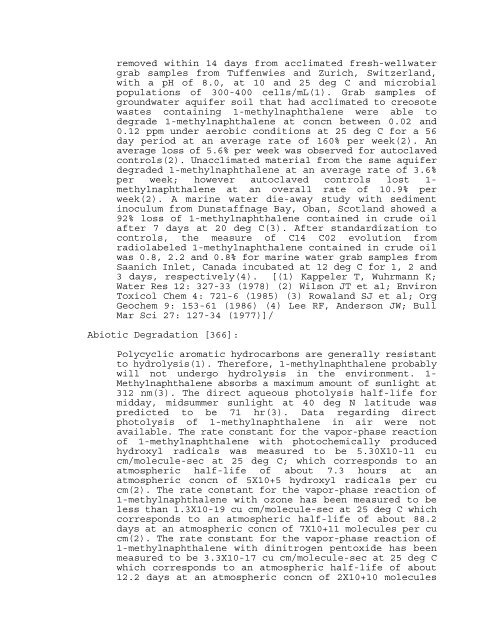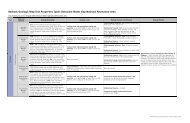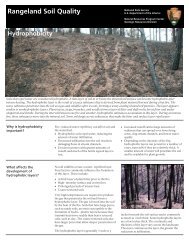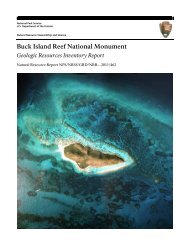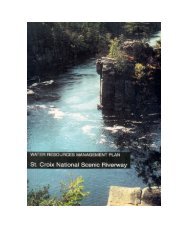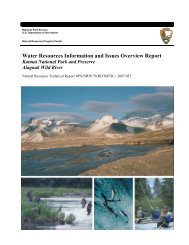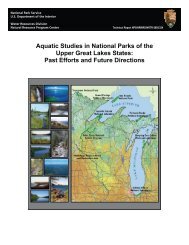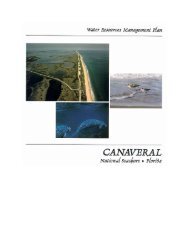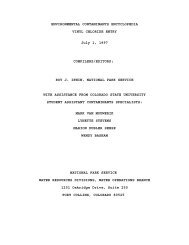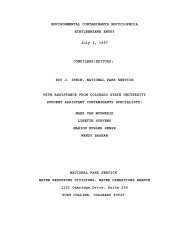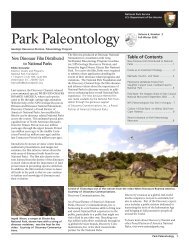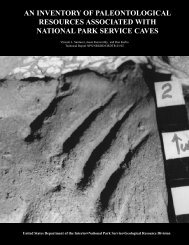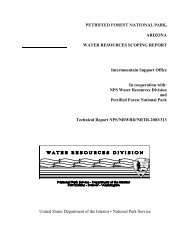Naphthalene, C1 - National Park Service
Naphthalene, C1 - National Park Service
Naphthalene, C1 - National Park Service
You also want an ePaper? Increase the reach of your titles
YUMPU automatically turns print PDFs into web optimized ePapers that Google loves.
emoved within 14 days from acclimated fresh-wellwater<br />
grab samples from Tuffenwies and Zurich, Switzerland,<br />
with a pH of 8.0, at 10 and 25 deg C and microbial<br />
populations of 300-400 cells/mL(1). Grab samples of<br />
groundwater aquifer soil that had acclimated to creosote<br />
wastes containing 1-methylnaphthalene were able to<br />
degrade 1-methylnaphthalene at concn between 0.02 and<br />
0.12 ppm under aerobic conditions at 25 deg C for a 56<br />
day period at an average rate of 160% per week(2). An<br />
average loss of 5.6% per week was observed for autoclaved<br />
controls(2). Unacclimated material from the same aquifer<br />
degraded 1-methylnaphthalene at an average rate of 3.6%<br />
per week; however autoclaved controls lost 1methylnaphthalene<br />
at an overall rate of 10.9% per<br />
week(2). A marine water die-away study with sediment<br />
inoculum from Dunstaffnage Bay, Oban, Scotland showed a<br />
92% loss of 1-methylnaphthalene contained in crude oil<br />
after 7 days at 20 deg C(3). After standardization to<br />
controls, the measure of <strong>C1</strong>4 C02 evolution from<br />
radiolabeled 1-methylnaphthalene contained in crude oil<br />
was 0.8, 2.2 and 0.8% for marine water grab samples from<br />
Saanich Inlet, Canada incubated at 12 deg C for 1, 2 and<br />
3 days, respectively(4). [(1) Kappeler T, Wuhrmann K;<br />
Water Res 12: 327-33 (1978) (2) Wilson JT et al; Environ<br />
Toxicol Chem 4: 721-6 (1985) (3) Rowaland SJ et al; Org<br />
Geochem 9: 153-61 (1986) (4) Lee RF, Anderson JW; Bull<br />
Mar Sci 27: 127-34 (1977)]/<br />
Abiotic Degradation [366]:<br />
Polycyclic aromatic hydrocarbons are generally resistant<br />
to hydrolysis(1). Therefore, 1-methylnaphthalene probably<br />
will not undergo hydrolysis in the environment. 1-<br />
Methylnaphthalene absorbs a maximum amount of sunlight at<br />
312 nm(3). The direct aqueous photolysis half-life for<br />
midday, midsummer sunlight at 40 deg N latitude was<br />
predicted to be 71 hr(3). Data regarding direct<br />
photolysis of 1-methylnaphthalene in air were not<br />
available. The rate constant for the vapor-phase reaction<br />
of 1-methylnaphthalene with photochemically produced<br />
hydroxyl radicals was measured to be 5.30X10-11 cu<br />
cm/molecule-sec at 25 deg C; which corresponds to an<br />
atmospheric half-life of about 7.3 hours at an<br />
atmospheric concn of 5X10+5 hydroxyl radicals per cu<br />
cm(2). The rate constant for the vapor-phase reaction of<br />
1-methylnaphthalene with ozone has been measured to be<br />
less than 1.3X10-19 cu cm/molecule-sec at 25 deg C which<br />
corresponds to an atmospheric half-life of about 88.2<br />
days at an atmospheric concn of 7X10+11 molecules per cu<br />
cm(2). The rate constant for the vapor-phase reaction of<br />
1-methylnaphthalene with dinitrogen pentoxide has been<br />
measured to be 3.3X10-17 cu cm/molecule-sec at 25 deg C<br />
which corresponds to an atmospheric half-life of about<br />
12.2 days at an atmospheric concn of 2X10+10 molecules


